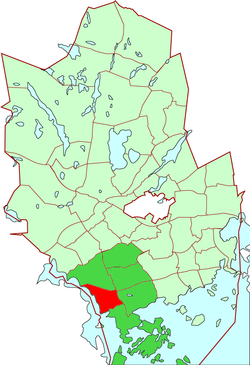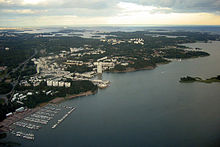You can help expand this article with text translated from the corresponding article in Finnish. (June 2023) Click for important translation instructions.
|
| Espoonlahti Esboviken | |
|---|---|
| District of Espoo | |
 Location of Espoonlahti within Espoo shown in green, Kanta-Espoonlahti in red. Location of Espoonlahti within Espoo shown in green, Kanta-Espoonlahti in red. | |
| Coordinates: 60°9′00″N 24°39′30″E / 60.15000°N 24.65833°E / 60.15000; 24.65833 | |
| Country | Finland |
| Municipality | Espoo |
| Region | Uusimaa |
| Sub-region | Greater Helsinki |
| Main District | Suur-Espoonlahti |
| Inner District(s) | Espoonlahden keskus, Kivenlahti, Laurinlahti, Soukka |
| Population | |
| • Total | 52,465 |
| Languages | |
| • Finnish | 83.0 % |
| • Swedish | 9.5 % |
| • Other | 7.4 % |
| Jobs | 2,821 |
Espoonlahti (Finnish) or Esboviken (Swedish) (literally The Bay of Espoo or Espoo Bay) is one of the five major urban areas of Espoo, a city in Finland. It lies along the south-western coast of Espoo, bounded to the west by the bay of the same name, to the south by the shores of the Gulf of Finland, to the west by the Finnoo (Finnå) valley, to the east of the municipal border of Kirkkonummi, and to the north by the forests of Espoo central forest area. This total area of about 4,800 hectares is further divided into areas called Soukka, Suvisaaristo, Kaitaa, Nöykkiö, Latokaski and Saunalahti, with one greater center called Espoonlahden keskus ( Espoonlahti center). Areas known as Laurinlahti, Ylä-Kivenlahti, Ala-Kivenlahti and Iivisniemi are also part of the Espoonlahti district. Yet another name pertinent to this area is Kanta-Espoonlahti (Espoonlahti Proper), which includes Espoonlahden keskus, Soukanmäki (Soukka Hill), Kivenlahti, Laurinlahti and Soukanniemi (Soukka Peninsula).
History

Areas along the Bay of Espoonlahti as well as the shores and islands of the Gulf of Finland belong to the oldest inhabited parts of Espoo with traces of human presence reaching to the Bronze Age. Certain pollens in sediment samples from Lake Hannusjärvi indicate permanent inhabitation and agriculture in and around the Bay of Finnoonlahti area about year 1000. The oldest villages in Espoonlahti are those of Soukka and Kivenlahti. They were important enough to be marked by their Swedish names Sökö and Stensvik on maps as early as in 1540. Espoonlahti Bay provided an important route for the Hanse trade ships and for those of the farmer salesmen from Espoo inland villages. Like all Espoo this area was still a typical rural area in the 1860s - only seldom disturbed by any industrial activity. The vast majority of changes that lead to modern Espoonlahti started with a great influx of new inhabitants after World War II. Things started to move rapidly after the Soviet Union returned the neighbouring Porkkala in 1956. The 1960s saw joined regional planning efforts between architects and housing companies who aimed to plan and build entire housing areas at one go. Those for the Soukka - Kivenlahti area were drawn by Alvar Aalto in 1964, while plans made for Laurinlahti by Espoo planners were successfully opposed by local residents assisted by the brothers Suomalainen. The most northerly point of Espoonlahti on the Bay of Espoonlahti is Saunalahti (Bastvik), whose urbanisation started in 2001 with asphatisation old roads and was followed in 2002 by intensive construction work of mainly residential buildings.
Modern times

With more than 52 000 inhabitants Espoonlahti is today the second largest of Espoo urban centers. It is a markedly residential area that in 2004 was able to employ 39% of its inhabitants. Espoonlahti center is characterized by a tree lined shopping street Espoonlahdenkatu, where most of the services are found. Among them is the shopping center Lippulaiva built in 1994, the market place, several banks and some small restaurants. The swimming hall, health center and Espoonlahti Church are all found close by. As Espoonlahden keskus is one of the stations of the western branch of the Helsinki metropolitan area underground (Länsimetro), further urban development is ongoing there. It includes several residential buildings, facilities for cultural services and an addition to Lippulaiva, which lies in the vicinity of the underground station, opened in 2022. There are five stations in the greater Espoonlahti area: Finnoo, Kaitaa, Soukka, Espoonlahti and Kivenlahti.
See also
References
- "Espoonlahden alueellinen esteettömyyskartoitus" (in Finnish). Espoo, Tekninen keskus. December 2009. Archived from the original on 12 March 2017. Retrieved 5 September 2015.
- Kylä, keskiaika Itämeren rannalla. Espoon kaupunginmuseon tutkimuksia 10. Helsinki 2008. ISBN 978-951-857-9. (A village, Middle Ages on the shores of the Baltic Sea) In Finnish.
- Matti J. Lahti: Espoo maalaispitäjästä suurkauppalaksi. Espoo-sarja. Pieksämäki 1975. ISBN 9789519522401. In Finnish.
- Johanna Pekkanen - Virve Heininen: Kuninkaankartanosta kaupungiksi. Viisi vuosisataa espoolaiselämää. AtlasArt, Riga 2013. ISBN 978-952-5671-46-9. In Finnish.
Notes
- "Espoo census 2013/2014". Archived from the original on 2014-10-23. Retrieved 2015-08-31.
- Districts on Espoo official web site
- Map showing Espoonlahti borders
- "Espoonlahden alueellinen esteettömyyskartoitus". Espoo, Tekninen keskus. December 2009. Retrieved 5 September 2015.Page 5.(in Finnish)
- Pekkanen&Heininen 2013, pages 10-11.
- Espoonlahden ae 2009, page 48.
- Kylä, page 75.
- Pekkanen&Heininen 2013, page 12.
- ^ "Espoon kotikaupunkipolut" (PDF). 30 September 2014.
- ^ Saloranta, Pauli (30 September 2014). "Espoon kotikaupunkipolut - Espoonlahti" (PDF). Espoo.fi. Espoo. Retrieved 6 September 2015.
- ^ Lahti 1975, page 329.
- "YLE Teema | Sininen laulu | Taiteilijat | Arkkitehtuuri ja taideteollisuus | Aalto Alvar ja Aino". yle.fi. Retrieved 2015-09-07.
- "Urban measurement sites". Water.tkk.fi. TKK, Water Resources Engineering. 17 November 2003. Archived from the original on 5 March 2016. Retrieved 7 September 2015.
- "Vuodenvaihteen väestö". Espoo.fi (in Finnish). Espoo. 11 April 2014. Archived from the original on 23 October 2014. Retrieved 5 September 2015. Espoonlahti census turn of the year 2013/2014.
- Espoonlahden ae 2009, page 21.
- Espoonlahden ae 2009, pages 19-21.
- "Espoonlahti underground station on the Länsimetro project site". Archived from the original on 2016-05-21. Retrieved 2015-09-08.
- Kaavoituskatsaus 2015 (in Finnish). Espoo. 2015. pp. 42–44. Archived from the original on 4 March 2016. Retrieved 5 September 2015. A look into town planning 2015.
